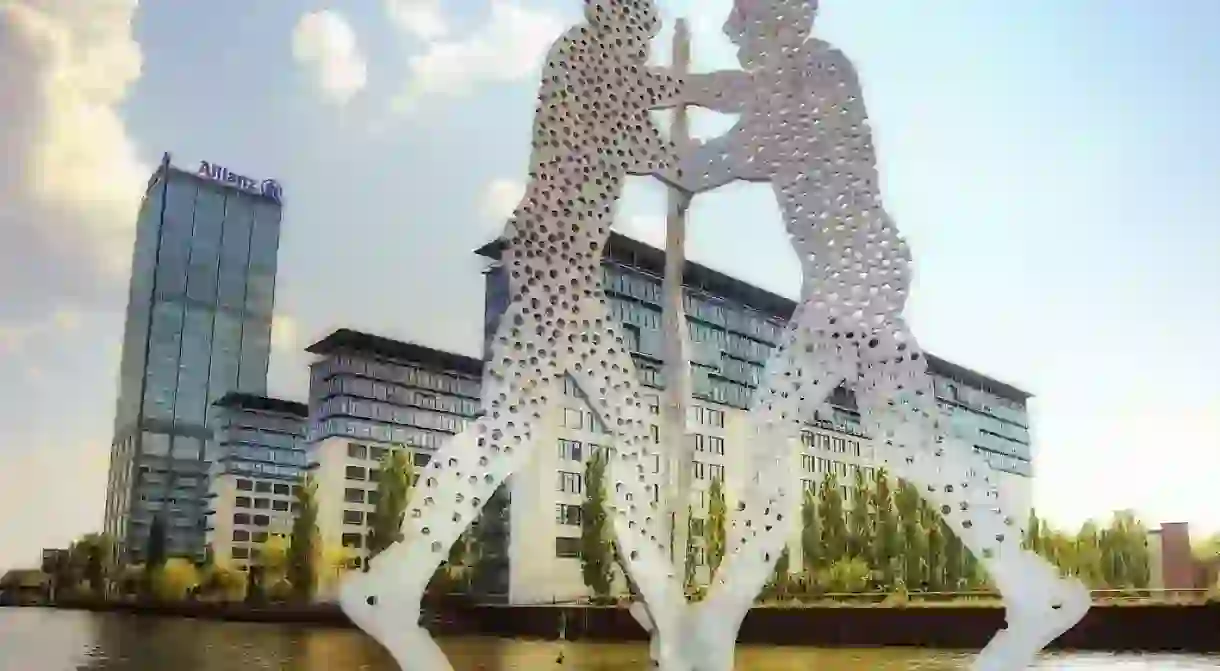The Top 8 Sculptures In Berlin

In a city so well known for its arts scene, it would only make sense that this fact would be evident on the very streets of Berlin. Indeed, renowned sculptures can be found throughout the city, many of which offer an aesthetic interpretation of the city’s distinct character and history. Here are the top eight to keep an eye out for.
Berlin by Brigitte and Martin Matchinsky
Church, Memorial
One of several sculptures designed for Berlin’s 750th anniversary in 1987, Berlin by Matchinsky evokes the motif of a broken chain. The statue is situated in the West, meant to signify the stark division between the city at the time. Berlin’s Church of Memory stands in the distance when spectators view the statue, which is further intended to provoke retrospection about everything that the city has endured throughout its history. Further, the statue is supposed to convey the perpetual desire to reunite and the proximity between the two sides, as implied through the fact that the chains are so close to linking.
Molecule Man by Jonathan Borofsky
Berlin’s Molecule Man is one of its most iconic statues. Towering over the Spree within which it stands, the statue is visible as people cross from either side of the river. Jonathan Borofsky, an American sculptor, completed the 30m aluminum statue in 1997, reminiscent of those that cropped up in Los Angeles during the 1970s. What makes this sculpture most intriguing is that it’s comprised of three two-dimensional men who are all leaning into one another. While the meaning behind this is left relatively open-ended, most believe that it is meant to symbolize the intersection point between the three localities where it stands: Treptow, Kreuzberg, and Friedrichshain.

Butterfly by Henry Moore
Building
Located outside of the aesthetically prominent Haus der Kulturen der Welt (House of World Cultures) in Tiergarten, the Butterfly by Henry Moore is the building’s most distinctive feature. The glimmering bronze statue weights about ten tons, spanning across the breadth of 4.5 meters. The Butterfly’s supple curving shape and multitude of finer details gives it a rather delicate, organic feel despite its density and metallic makeup. Butterfly was another statue commissioned in celebration of Berlin’s 750th birthday, and it is commonly regarded as one of Henry Moore’s greatest works.
Balloon Flower by Jeff Koons
Jeff Koons’ Balloon Flower in Potsdamer Platz is one of the city’s most notorious works of sculpture. The electric blue sheen of the stainless steel structure truly makes it look like an enormous balloon animal. Koons himself is world-famous, as one of the highest paid artists in the world. His piece, Balloon Dog (Orange) sold for $58.4 million at auction in New York, which now holds the record for the most expensive work of art by a living artist. He decided to grace Berlin with the Balloon Flower, done in his purely distinctive style in 2000.
Boxers by Keith Haring
Keith Haring’s Boxers was yet another installation in celebration of Berlin’s birthday in 1987. This one is situated in front of the world-renowned Berlin Philharmonie. The respective blue and red boxers stand at 5 meters in height, and each is punching a hole other’s head and torso. Yet, what makes this work so interesting is the notion that the boxers are actually fighting is relatively vague. Some believe the two are actually passionately embracing. The figures are designed in Haring’s distinct comic-strip style, utilizing bright, bold colors and simple designs.
Galileo by Mark di Suvero

Galileo stands on the water’s surface, not far from Potsdamer Platz. The structure is comprised of various metallic and wooden implements fastened together to create a large, oxidizing contraption. The structure is meant to express instantaneous motion, frozen in time. It is certainly fascinating to gaze upon it and consider Galileo‘s many different facets, which co-mingle in expressive ways, and the sculpture is best observed when it is explored from all sides. Galileo was first built in 1996, and it was acquired in 1998. Of course, based on its name, the sculpture is also meant to conjure notions of the famous astronomer’s many different scientific, planetary models.
Berlin by Eduardo Chillida
Building
Another sculpture made notable because of its rusting exterior is Berlin by the Spanish sculptor, Eduardo Chillida. Built in the year 2000, the structure itself is comprised of two robust pillars that entangle with one another at the top. The motif is meant to indicate the nature of separation and unification that the city has experienced. It is located in the yard of the Federal Chancellery building, where Merkel and many other prominent governmental figures work, functioning as a reminder of the dangers of ideological divisiveness.
Drei Mädchen und ein Knabe by Wilfried Fitzenreiter
Cathedral, Museum
The lovely ladies – and one boy – by Wilfried Fitzenreiter, situated on the Spree promenade near Museum Island at the city center, are casually sitting nude at the water’s edge. Titled, in English, Three Girls and a Boy, the life-size statues are situated across the river from the Berlin Cathedral, and were made from 1977-1979, though their classic style gives them the appearance of being much older. These beautiful, lifelike figures are often the site of photo ops as tourists and passersby pose next to them. Otherwise, they exude the carefree air of confidence and comfort in one’s own skin that feels rather apt for the city.













